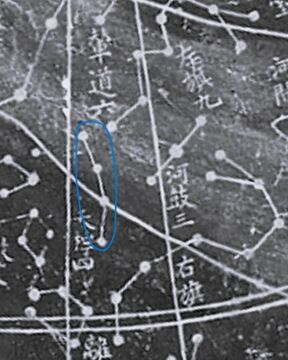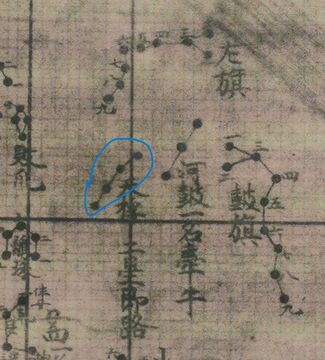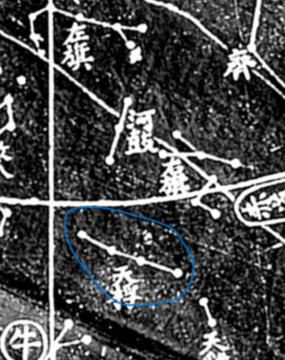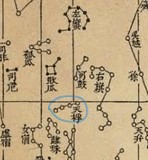Tianfu
Tianfu
Chinese constellation.
Etymology and History
Tianfu contains four stars and literally translates to "Celestial Drumstick." This asterism belongs to the Wu Xian school and is depicted in yellow on ancient Chinese celestial globes and maps. The origin of this asterism postdates the one referred to as "Hegu (河鼓, Drum at the River)" by the Shi school because, by its literal meaning, Tianfu is used to strike the drum. Since the Hegu was primarily associated with military war drums in astrology, Tianfu is also considered related to the military. Additionally, drums were essential timekeeping tools in ancient China, so Tianfu is endowed with significant attributes related to timekeeping. According to the ancient Chinese astrologers, if the stars of Tianfu dim, it could lead to inaccuracies in timekeeping.
According to descriptions from the Wu Xian and Huangdi schools, Tianfu is located to the left of the three stars of the Hegu[1]. Ancient star maps before the Tang Dynasty correspond to this description, but the position of this asterism shifted downwards after the Song Dynasty.
Identification of stars
| Star Names or Orders(Traditional/Qing) | Ho PENG YOKE[2] | Yi Shitong[3]
Based on catalogue in 18th century |
Pan Nai[4]
based on Xinyixiangfayao Star Map |
Pan Nai[5]
based on catalogues in Yuan dynasty |
SUN X. & J. Kistemaker[6]
Han Dynasty |
Boshun Yang[7]
before Tang dynasty |
Boshun Yang[7]
Song Jingyou(1034) |
|---|---|---|---|---|---|---|---|
| 1st/4th | eta Aql | eta Aql | eta/58 Aql | eta Aql | eta Aql | phi Aql | 69 Aql |
| 2nd/3rd | 58 Aql | 58 Aql | 62 Aql | 58 Aql | 58 Aql | Hip 98526 | 66 Aql |
| 3rd/2nd | 62 Aql | 62 Aql | tet Aql | 62 Aql | 62 Aql | tau Aql | tet Aql |
| 4th/1st | tet Aql | tet Aql | HIP 100232 | tet Aql | tet Aql | Hip 100541 | 62 Aql |
Images
- Tianfu
Star Name Discussion (IAU)
In 2024, the name of the historical constellation "Tianfu" was suggested to be used for one of the stars in this constellation. The identifications of the four stars vary over time. The bright stars η and θ had been identified by scholars in the 20th century but are now considered uncertain (possibly incorrect) suggestions. Although the new identification makes the early version of the constellation Tianfu consisting of only faint stars(>5), this identification is preferred about the astrological significance of the asterism in this historical time: the "celestial drum stick" placed close to the asterism of the "drum". With the new identifications (before and after the Tang Dynasty), the stars ϕ and τ are the brightest ones in the asterism. Although ϕ Aql is a bit brighter, whether it formed part of the asterism in earlier epochs is uncertain. Hence, τ Aql is suggested to be named "Tianfu".
References
- ↑ Qutan Xida. Kaiyuanzhanjing 开元占经. Jiuzhou Press, P. 705.
- ↑ P.-Y. Ho, “Ancient And Mediaeval Observations of Comets and Novae in Chinese Sources,” Vistas in Astronomy, 5(1962), 127-225.
- ↑ Yi Shitong伊世同. Zhongxi Duizhao Hengxing Tubiao中西对照恒星图表1950. Beijing: Science Press.1981: 56.
- ↑ Pan Nai潘鼐. Zhongguo Hengxing Guance shi中国恒星观测史[M]. Shanghai: Xuelin Pree. 1989. p226.
- ↑ Pan Nai潘鼐. Zhongguo Hengxing Guance shi中国恒星观测史[M]. Shanghai: Xuelin Pree. 2009. p443.
- ↑ Sun Xiaochun. & Kistemaker J. The Chinese sky during the Han. Leiden: Brill. 1997, Pp241-6.
- ↑ 7.0 7.1 B.-S. Yang杨伯顺, Zhongguo Chuantong Hengxing Guance Jingdu ji Xingguan Yanbian Yanjiu 中国传统恒星观测精度及星官演变研究 (A Research on the Accuracy of Chinese Traditional Star Observation and the Evolution of Constellations), PhD thesis, (Hefei: University of Science and Technology of China, 2023). 261.








